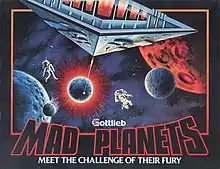Mad Planets
Mad Planets is a multidirectional shooter released as an arcade video game in 1983 by Gottlieb. The player controls a spaceship, which can be moved and rotated independently, to fend off angry planets and moons attacking from all sides. It was designed and programmed by Kan Yabumoto[3][4] with art by Jeff Lee and sound by David D. Thiel.[3] Lee and Thiel previously worked on Q*bert for Gottlieb,[5] a game that was inspired by a pattern of hexagons implemented by Yabumoto.[6] Kan Yabumoto died in 2017 of a degenerative lung disease.[7][8]
| Mad Planets | |
|---|---|
 | |
| Developer(s) | Gottlieb |
| Publisher(s) | Gottlieb |
| Programmer(s) | Kan Yabumoto |
| Artist(s) | Jeff Lee |
| Composer(s) | David D. Thiel |
| Platform(s) | Arcade |
| Release | |
| Genre(s) | Multidirectional shooter |
| Mode(s) | 1-2 players alternating turns |
| Arcade system | GG-III[2] |
Gameplay

The player uses a flight-style joystick to move a spaceship around a dark starfield, a rotary knob to orient the ship, and a trigger on the stick to fire.[9] At the beginning of a level, planets appear and begin growing. They can be destroyed prior to their reaching full size and sprouting moons. If a wave is completed by destroying all planets before they reach full size, a substantial bonus is awarded. Once a planet has moons, it is shielded until all its moons have been destroyed or launched at the player's ship, at which point the planet becomes enraged and charges the player.
Erratically moving astronauts can be collected by flying over them. They also appear in bonus rounds after every third level (every fourth after level twelve). Orbiting comets accelerate the longer they go without being shot. In a bonus round, comets increase in value by 100 points, to a maximum of 1000, until a comet leaves the screen or the level ends.[10]
Reception
Writing for Creative Computing Video & Arcade Games, Steve Arrants chose Mad Planets as one of the top ten games of the 1983 American Amusement Operators Expo. He praised the "beautiful graphics", "extremely responsive" controls, and concluded "I would rank Mad Planets right up there with other high-tension favorites such as Robotron and Tempest."[9]
In a 1983 review for Video Games, John Holmstrom wrote: "it's the frenetic game play and rock-oriented soundtrack that make Mad Planets worth playing."[11] He found the player's ship to be overly large for the screen, and the lack of new elements in later levels reduced his interest in sticking with the game.[11]
Legacy
Programmer Simon Nicol wrote two clones for the Commodore 64, both published by Martech: Crazy Comets and its sequel Mega Apocalypse.[12]
References
- "Mad Planets [Model GV-102]". arcade-history.com. Retrieved October 6, 2018.
- "Gottlieb Video System Boards". mikesarcade.com. Retrieved October 6, 2018.
- "Mad Planets". Arcade History.
- Hague, James. "The Giant List of Classic Game Programmers".
- "Q*bert". Arcade History.
- Davis, Warren. "The Creation of Q*bert". coinop.org.
- "Dr. Kan Yabumoto - Creator of Mad Planets passed away". KLOV forums. April 4, 2017.
- "Kan Yabumoto: Mad Planets". The Arcade Blogger. 2017.
- Arrants, Steve (Fall 1983). "New Top 10 Games at the AOE '83". Creative Computing Video & Arcade Games. 1 (2).
- Sabbatini, Mark. "MAME Reviews: Mad Planets". Retrogaming Times.
- Holmstrom, John (August 1983). "Coin-op Shop: Mad Planets". Video Games. 1 (11): 44–45.
- Wilkins, Chros (May 8, 2016). "C64Gems : Mega Apocalypse". Retro Now!.